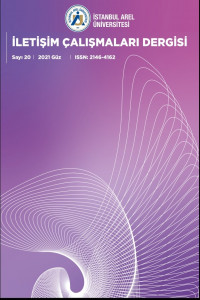DÜNYA DÜĞÜNDEN İBARETTİR: REALITY SHOW BAĞLAMINDA “ZUHAL TOPAL’LA SOFRADA” PROGRAMI ÖRNEĞİ
Reality showlar, özellikle yerel platformlara yayılmış bir dizi sosyal alana nüfuz etme kabiliyeti
ile öncelikle Hollanda’da ortaya çıkmış ve ardından dünya çapında geniş bir popülerliğe
ulaşmıştır. Ayrıca bu tarz programlar gerçek durumlar içinde kalan gerçek insanların
arasındaki ilişkileri, reyting amacıyla imal edilmiş performanslarla da bulanıklaştırmıştır.
Bu gösterilerde bir vitrin oluşturulmuş, bu vitrine çıkan oyuncular da performanslarıyla
sundukları dramaları izleyicilerin ev rahatlığında, oturma odalarına getirmek suretiyle
buluşturmuştur. Bu çalışmada amaç izleyicilerin programa dair izleme motivasyonlarını
ortaya koymak, sunucunun programdaki rolünü Goffman’ın Günlük Yaşamda Benliğin
Sunumu kitabında belirttiği öncüllere bağlı kalarak değerlendirmek ve programdaki
cinsiyet rollerine dair izleyici görüşlerini analiz etmektir. Çalışmada programı izleyen
yedi kişi ile derinlemesine mülakat yöntemi kullanılmıştır. Görüşmeler sonucunda elde
edilen bulgular ‘’izleme motivasyonu, mahremiyet, sunucu rolü, yarışmacı rolü ve cinsiyet
rolleri’’ isimlendirmeleriyle beş başlıkta analiz edilmiştir. Buna göre, sunucunun sergilediği
performans görüşmeciler nezdinde gerçek olarak algılanmakta, programda kadın temsili
yemek ve ev işi yapma gibi formlar üzerinden anlatılmaktadır. Bu makale kapsamında kısıtlı
biçimde çalışılan Reality Show formatı, gerçeklik ile kurguyu birbirinden ayırmanın zor
olması yönüyle farklı programlar üzerinde ve daha geniş bir örneklem seçilerek daha detaylı
biçimde araştırılmalıdır.
Anahtar Kelimeler:
Reality Show, gerçeklik televizyonu, benlik, vitrin, performans
THE WORLD IN TRUTH IS A WEDDING: EXAMPLE OF "ZUHAL TOPAL'LA SOFRADA" IN THE CONTEXT OF REALITY SHOW
Reality shows first appeared in the Netherlands with the ability to penetrate a range of social
areas, were primarily seen in the local area, and subsequently reached a wide popularity
worldwide. This format has blurred the lines between real people in real situations by the help
of the performances produced for the purpose of rating. In these performances, a showcase
has been created, and the actors who were playing in this showcase staged the dramas they
presented with the performances. These dramas were watched by the audiences in their
comfortable living rooms. In this respect, the aim of this study is to reveal the audiences’
motivation while they were watching these programs. Also, this study evaluates the role of the
presenter in the program by adhering to the predecessors stated in Goffman's Presentation
of Self in Daily Life and analyses the views of the audience on gender roles in the program. In
the study, in-depth interview method was used with seven people who are the audiences of
the program. The findings of the interviews were analysed under five headings: “monitoring
motivation, privacy, presenter’s role, competitor’s role and gender roles”. The performance
of the presenter is perceived as real in the presence of the interviewers, and the program is
explained through forms such as female representative food and housework. According to
this, the performance of the presenter is perceived as real in the presence of the interviewers,
and the program is explained through forms such as female representations for cooking and
housework. The reality show format, which has been studied in a limited manner within the
scope of this article, should be explored in more detail by selecting a larger sample on different
programs based on its characteristic which is hard to make a differentiation between reality
and fiction.
Keywords:
Reality show, reality television, self, display, performance,
___
- Baudrillard, Jean (2005) Simülakrlar ve Simülasyon. Oğuz Adanır (çev.), Ankara: Doğu Batı Yayınları Chung, Siyoung ve Cho Hichang (2014) “Parasocial Relationship via Reality TV and Social Media: Its implications Forcelebrity Endorsement”. Research Collection Lee Kong Chian School Of Business. s. 47-54.
- Çetinbaş, Tuba (2016) Medya Gösterisi ve Bireylerin Metalaşması: Bu Tarz Yarışması. Uluslararası Hakemli İletişim ve Edebiyat Araştırmaları Dergisi. Ocak / Şubat / Mart – Kış Dönemi Sayı: 14 Yıl: 2017 s.1-20.
- Dursun, Çiler (2013) İletişim Kuram Kritik. Ankara: İmge Kitabevi. Fawkes, Johanna (2014) “Performance and Persona: Goffman and Jung's approaches to professional identity applied to public relations”. Public Relations Review. Mart. Sayı 41, s: 1-17.
- Goffman, Erving (2014) Günlük Yaşamda Benliğin Sunumu. Metis Yayıncılık.
- Göker, G. (2015) “Tele-yaşamlar: Gerçeklik ve Kurgu Bağlamında Türkiye'de Realite Programlar”, Global Media Journal TR Edition, Cilt: 6, Sayı: 11, 261-282.
- Hill, A. (2005) Reality TV: Audiences and Popular Factual Telvision. London: Routledge.
- İlhan, Vahit ve Usta, Derya (2018) “Televizyonda Gündüz Kuşağı Programlarındaki Dönüşüm: Esra Erol’da Örneği”, Erciyes İletişim Dergisi. Temmuz 2018 Cilt: 5, Sayı: 4, s: 571-598.
- Mast, Jelle (2016) The Dark Side of Reality TV:Professional Ethics and the Treatment of Reality Show Participants. International Journal of Communication Vol., s. 2179–2200.
- Palmer, G. (2006) Video vigilantes and the work of shame. Jump Cut, 48. Erişim Adresi: http://www.ejumpcut.org/archive/jc48.2006/shameTV/
- Piper, Helen (2006) Understanding Reality Television Reality TV –Audiences and Popular Factual Television Reality TV, Realism and Revelation. Cilt 47, Issue 1, Bahar 2006, Pages 133–138.
- Türkoğlu, Nurçay (2010) Toplumsal Dönüşümler ve Medyada İzleyici Katılımı. Tübitak Raporu Proje No: 110K004 (2515-COST-SOBAG), s. 1-184.
- ISSN: 2146-4162
- Yayın Aralığı: Yılda 2 Sayı
- Başlangıç: 2017
- Yayıncı: İstanbul Arel Üniversitesi
Sayıdaki Diğer Makaleler
MEDYA, GENÇLİK, SUÇ VE AHLAKİ PANİK
DÜNYA DÜĞÜNDEN İBARETTİR: REALITY SHOW BAĞLAMINDA “ZUHAL TOPAL’LA SOFRADA” PROGRAMI ÖRNEĞİ
TÜRKİYE'DE DİJİTAL PAZARLAMADA MARKA VE TÜKETİCİ İLİŞKİSİNİN İNCELENMESİ
TEKNOLOJİ, SİBER-UZAM VE BEDEN: SCHUSTERMAN’IN “SOMATİK DÖNÜŞ”Ü VE SİBER-UZAM ELEŞTİRİSİ
